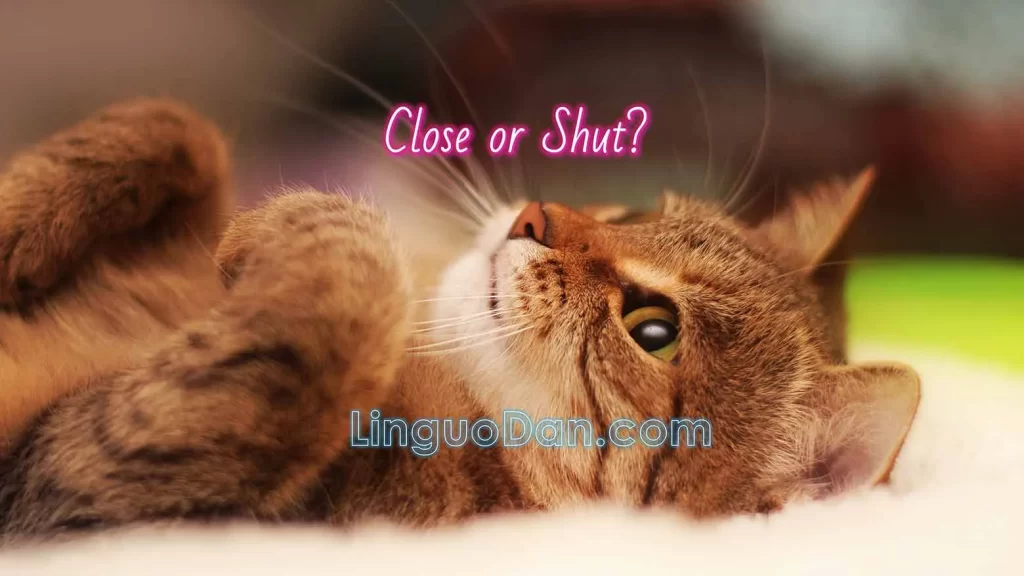Difference between Shut and Close in practice

Understanding the Differences: “Shut” vs “Close” in English
When learning English, we often come across words that have similar meanings and in some cases we do not know which one to choose (such words are called synonyms). Two such words that often cause confusion are “shut” and “close.” At first glance, it is difficult to choose one of them, but it all depends on the context. The words “shut” and “close” may seem synonymous, especially in expressions like “shut/close the door.” However, “shut” can have a more emotional, often angry or aggressive, sharp meaning to forcefully close a door, while “close” has a more neutral and general meaning. The verb “close” can also convey the act of reducing the distance between objects or between people, which is usually expressed by the phrase “close the gap”. For example, in a race, if one driver is closing in on another driver, it can be said that he is “closing the gap”. Also, close” can be used for metaphorical concepts, such as “closing the gender pay gap,” that is, working to eliminate inequality. In this sense, “shut” is not used. Let’s take a closer look.
At the end of the article, test your knowledge in practice.
Close – usage in English
The verb “close” is versatile and finds application in various contexts. It generally implies bringing things together or sealing a gap. When discussing doors, windows, books, or containers, you use “close.” For instance:
- Close the door quietly.
- She decided to close the book and take a break.
- It’s time to close the suitcase before we leave.
“Close” extends beyond the physical realm and is also employed in abstract contexts:
- The conference will close with a summary of key findings.
- Let’s close this chapter of our discussion and move on.
Shut – usage in English
While “shut” is often used interchangeably with “close,” it is more specific in its application. “Shut” typically suggests a forceful or complete closing, emphasizing the action of sealing off an entrance or closing with a decisive motion. Consider the following examples:
- Shut the window; it’s getting cold.
- I asked him to shut the gate behind him.
- She shut her eyes and tried to relax.
“Shut” is frequently used in situations where a firm or forceful action is required, emphasizing the completeness of the closure.
Close or Shut?
1. General Definition:
- Shut: Typically implies an action where something is being brought to a closed position, often with a bit of force or immediacy.
- Close: Can also mean bringing something to a closed position, but it carries a connotation of completing an action or doing it with intention and care.
2. Context of Use:
Shut: This word is commonly used in everyday conversations and can come across as less formal. You might shut a door, shut a window, or tell someone to “shut the book” after finishing it. It also forms part of idiomatic expressions such as “shut down” a computer or “shut up,” which is an informal way to tell someone to stop talking.
Close: “Close” is often used when you want to convey a more formal or gentle action. You might close a deal, close a bank account, or gently close the lid of a piano. It’s also used in phrases such as “close out” an account or “close off” an area.
3. Closed permanently or temporarily:
- Shut: This word can imply abruptness and sometimes finality. Saying “The shop is shut” can infer that it is closed for the day or for good without specifying.
- Close: Conveys a sense of completion without an abrupt or harsh tone. Telling someone “The office is closed” usually means it is not open for business at that time but implies it will reopen.
4. Emotional Context:
- Shut: When used in an emotional context, “shut” can imply a kind of barrier or distance, like “shutting someone out” emotionally.
- Close: Emotional usage of “close” might involve bringing an end to a discussion or relationship in a more thoughtful manner, such as “closing a chapter” in one’s life.
5. Grammar and Usage:
- “Shut” is both a verb and an adjective. As an adjective, it simply means “in a closed position,” as in: “The doors remained shut for the night.”
- “Close” can be a verb, an adjective, or an adverb. However, when used as an adjective, it carries a different meaning, referring to proximity rather than the state of being not open. For instance, “The school is close to my house.”
The main difference between “close” and “shut” is that they are used with different nouns and in different contexts. Example:
- “Shut” is used specifically for objects such as valves, doors, windows, and other physical barriers that can be tightly closed to block access or prevent passage.
- “Close” is used in a broader sense and can be associated with the end or completion of an activity, a place that ceases to operate, or something that comes to an end.
- “Shut” is also associated with a sense of confinement or isolation, while “close” can refer to the act of blocking or preventing something.